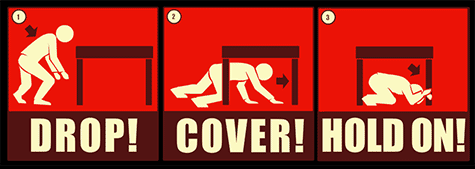
Earthquake preparedness drill set for 10:17 a.m. Oct. 17
To help ensure the Washington University in St. Louis community is prepared in
the event of an earthquake, a voluntary earthquake safety drill will be held
for all WUSTL faculty, staff and students at 10:17 a.m. Thursday, Oct. 17.
The drill is part of the 2013 Great Central U.S. ShakeOut, organized by the Central U.S. Earthquake Consortium.
ShakeOut is billed as a national “Whole Community Day of Action,” where more than 40 states and territories will participate in earthquake-safety activities.
More than 12 million people are expected to participate in ShakeOut drills nationwide.
St. Louis is located in the New Madrid Seismic Zone, an area that has a history of large earthquakes. It is expected that if another large earthquake occurs in the region, it would cause significant damage and disruption to WUSTL campuses and the greater St. Louis area.
Those who wish to participate should practice Drop, Cover and Hold On for 60 seconds at 10:17 a.m. — or at a minimum discuss earthquake safety with faculty, staff and students in your area.
The Emergency Management Program will not issue a WUSTLAlert to announce the drill.
Mark Bagby and Ty Davisson, WUSTL Emergency Management Program directors, recommend university community members follow these six steps to prepare for and stay safe in the event of an earthquake:
1) Take a few minutes to identify and reduce possible hazards that may harm you in a work or living area, such as:
- Top-heavy, freestanding items that could topple;
- Heavy or breakable items on high shelves; and
- Heavy items hung on the wall or ceiling near a work, sitting or sleeping area.
2) Know what to do during and after an earthquake by becoming familiar with directions on emergency.wustl.edu.
3) Prepare a small personal disaster kit that could last at least three days.
4) Practice “Drop, Cover and Hold On.” As you feel an earthquake beginning, immediately drop to the floor, seek cover under a sturdy structure such as a table or desk, and hold on to that structure.
5) After an earthquake occurs, check for injuries and life-threatening damage.
6) Follow WUSTL’s disaster instructions and communications. Emergency signage and assembly points are posted throughout WUSTL campuses.
Through WUSTLAlerts, the university uses contact information in HRMS and WebSTAC/SIS to contact individuals by email, phone and text message when necessary in an emergency. WUSTL community members are strongly encouraged to update their contact information via HRMS and WebSTAC/SIS.
For more information about what do in the event of an earthquake and other emergencies, visit emergency.wustl.edu.
The 2013 ShakeOut drill is estimated to be the largest preparedness event in central U.S. history.
For more information, visit here or contact Davisson (Medical School Campus) at davissont@wustl.edu or Bagby (all other campuses) at bagbym@wustl.edu.